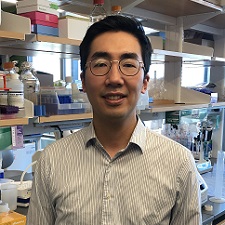Rebecca L. Zon, MD

Thalidomide derivatives are a mainstay of treatment in multiple myeloma, a cancer of white blood cells called plasma cells. However, around one in ten individuals treated with thalidomide derivatives for multiple myeloma will develop a blood clot, which can be life-threatening. It is critical to determine how to continue to use thalidomide derivatives to kill myeloma cells, while working to understand why these drugs increase the likelihood of clotting. Thalidomide derivatives work by degrading proteins important to myeloma cell growth; Dr. Zon [The Mark Foundation for Cancer Research Physician-Scientist] hypothesizes that these drugs could similarly lead to the degradation of proteins that prevent blood clotting. She is comprehensively evaluating what factors promote blood clots patients with multiple myeloma, with the goal of developing more targeted medications to prevent blood clots and improve treatment outcomes in blood cancer patients.
Vignesh Shanmugam, MD

It has been long recognized that B-cell malignancies such as follicular lymphoma (FL) are dependent on interactions with nearby non-malignant cells for survival. However, this dependency has yet to be exploited therapeutically. Dr. Shanmugam aims to define the pro-tumorigenic growth factors in the environment around malignant B cells in FL and elucidate the mechanisms of how these growth factors promote FL cell survival and proliferation. This knowledge will enable the development of new treatments that block these interactions and new laboratory models of follicular lymphoma.
Xiaoli Mi, MD
Chimeric antigen receptor (CAR) T cells are a type of immunotherapy that uses genetically engineered T cells from patients to treat cancer. While a one-time treatment has the potential to generate long-term protection from relapse, CAR T cells often fail due to poor persistence. Dr. Mi recently studied samples from patients with durable remissions of leukemia and found that rare persistent CAR T cells share a distinct set of molecular and cellular features. She will now define the properties of persistent CAR T cells across multiple blood cancers, trace their T cell origins and evolutionary dynamics using novel technologies, and experimentally evaluate her findings in preclinical models. These studies could illuminate how CAR T cells change over time in patients and help guide development of future cellular therapies with more durable effects for patients with different types of cancers.
Rahul S. Bhansali, MD

Dr. Bhansali is studying how epigenetic processes—specifically the three-dimensional folding of DNA—promote the development, growth, and survival of cancers. His research focuses on T-cell acute lymphoblastic leukemia (T-ALL), an aggressive blood cancer affecting both children and adults for which traditional chemotherapy remains the mainstay of treatment. LDB1 is a protein involved in the process of DNA folding that partners with another protein called LMO2, which is highly expressed in up to 75% of T-ALL. Dr. Bhansali hypothesizes that LDB1/LMO2 rewire the normal gene expression machinery in our blood cells in a way that activates cancer-promoting genes to cause leukemia. Targeting this process may shed light on new treatment avenues and ways to overcome resistance to treatment.
Nina Weichert-Leahey, MD

Neuroblastoma is a rare pediatric cancer that typically arises in the adrenal glands, located above the kidney. Children with high-risk neuroblastoma often have poor prognoses despite intense treatment-including maintenance treatment with retinoic acid-underscoring the need for new treatments to improve long-term outcomes. Retinoic acid, which is orally available and generally well tolerated, helps neuroblastoma cells mature (differentiate) into normal cells; however, this process is entirely reversible once the retinoic acid is withdrawn. If this differentiating effect could be made permanent with the addition of a second drug, a combination treatment with retinoic acid could become a novel method of preventing patient relapse. After testing a panel of 452 small molecule drugs, Dr. Weichert-Leahey discovered that a drug called PF-9363 accentuated the effects of retinoic acid in neuroblastoma the most. She will now study how PF-9363 functions, alone and together with retinoic acid, both in cells and patient-derived neuroblastoma models in mice. These experiments will indicate whether combinations of this new compound with retinoic acid may improve outcomes for children with high-risk neuroblastoma.
Mounica Vallurupalli, MD

Before a gene can be expressed, a protein known as a splicing factor must remove non-coding regions (introns) from the RNA strand. Mutations in splicing factors, and specifically one called SF3B1, can lead to the development of certain blood cancers. Dr. Vallurupalli [David M. Livingston, MD, Physician-Scientist] will use genome editing technologies to generate and characterize SF3B1-mutant models in human adult blood stem cells. She will also screen for other genetic factors that may influence the outcome of SF3B1 mutations. Her goal is to identify previously unrecognized therapeutic targets for treating splicing factor-mutated blood cancers.
Nicole M. Cruz, MD

About 70% of pediatric leukemias and up to 10% of adult leukemias are caused by a genetic disruption in which the mixed lineage leukemia (MLL) 1 gene breaks off and attaches to a different chromosome. This event, known as a chromosomal translocation, gives rise to a distinct subset of leukemias called MLL-rearranged acute myeloid leukemia (AML). Studies have shown that a protein called KMT2D plays a critical role in the development of MLL-rearranged AML. However, the potential of KMT2D as a novel therapeutic target remains underexplored. Dr. Cruz [The Mark Foundation for Cancer Research Physician-Scientist] will use molecular biology, epigenetic, and biochemistry approaches to describe the precise molecular mechanism by which KMT2D regulates gene expression in MLL-rearranged AML. Her work will provide insight into potentially targetable proteins for this aggressive blood cancer.
Wallace A. Bourgeois, MD

Acute myeloid leukemia (AML) with rearrangements of the KMT2A gene (KMT2A-r) or NPM1 mutation (NPM1m) affect children and adults and can be difficult to treat even with highly intensive therapy. Targeted, less toxic therapies are urgently needed. Menin inhibitors are novel small molecules that block a critical interaction between the KMT2A protein and another protein called menin. This protein-protein interaction is essential in sustaining both KMT2A-r and NPM1m AML. Menin inhibitors have now entered clinical trials for children and adults have shown promising results. However, it has also been demonstrated that up to 40% of patients will develop resistance to a menin inhibitor when it is given alone due to a mutation in the MEN1 gene, which encodes the protein menin. Dr. Bourgeois is investigating whether combination therapy can prevent or overcome MEN1 mutations that confer resistance to menin inhibitors. Additionally, he is developing models to understand how and why resistance to menin inhibitors is sometimes driven by MEN1 mutations, but other times not. The overarching goal of the project is to identify combination therapies that prevent and overcome menin inhibitor resistance and to better understand the different ways in which resistance to menin inhibitors develops.
(Peter) Geon Kim, MD

Blood stem cells, which give rise to various blood cells in the body, acquire mutations with increasing frequency as we age. In the absence of blood cancer development, this state is called clonal hematopoiesis. Up to a quarter of individuals over 60 years old will have recurrent mutations detected in their blood. Recent studies suggest that those with clonal hematopoiesis have an increased risk of developing heart disease and blood cancer, as well as increased levels of inflammatory cytokines – signaling molecules released by immune cells to promote inflammation. Dr. Kim will dissect the mechanisms underlying increased inflammation, which could provide insight into various inflammatory conditions associated with clonal hematopoiesis and potentially elucidate how clonal hematopoiesis progresses into blood cancer.
Albert E. Kim, MD

A feared complication of malignant solid tumors is the development of brain metastases (BM), for which current treatments are limited and morbidity is high. While precision medicine approaches for BM have recently demonstrated promise, many patients are not able to benefit from this treatment approach as molecular analysis of BM tissue is not usually feasible. To address this obstacle, Dr. Kim [William G. Kaelin, Jr., MD, Physician-Scientist] will apply genomic profiling and deep learning methods to a rich dataset comprised of BM tissues, patient-matched brain MRIs, and cell-free DNA samples to develop techniques that reveal therapeutic targets within a patient’s BM. He hopes to identify ways to non-invasively characterize oncogenic drivers for a BM or monitor tumor evolution. These findings will demonstrate the potential of using algorithmic tools in the clinic to augment clinical decision-making and unlock opportunities for widespread application of precision medicine for BM.
